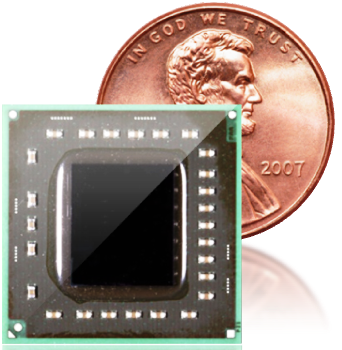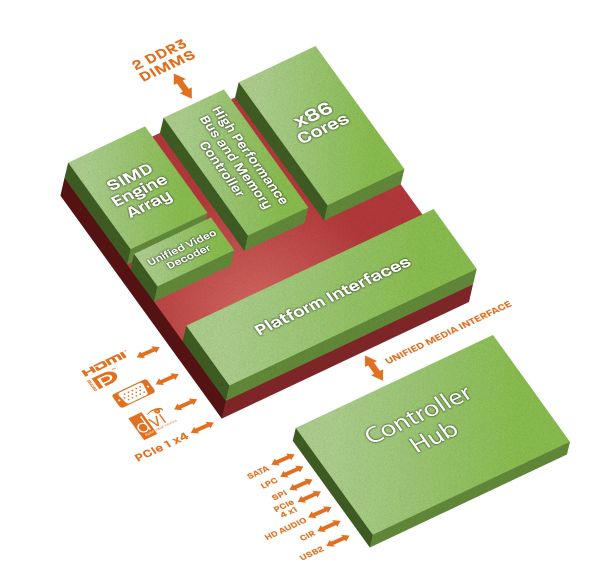AMD G-Series Brings APUs to the x86 Embedded Market
by Ganesh T S on January 19, 2011 12:29 AM ESTThe embedded market is huge and growing, and needs innovative, complete system platforms. These systems are compute intensive and have high performance graphics requirements, which make the embedded market a key part of AMD's strategy to drive revenue growth. There is an ongoing push for decreased power, smaller size and higher capability systems at lower price points. The strong visual element and growing need for quality graphics in many embedded markets such as set top boxes make it the ideal time for the AMD APU to get introduced into this space.

AMD's solutions (integrated CPU + GPU) are ideal for thin clients, medical imaging, point of sale and kiosk systems, gaming machines, digital signage and single board computing systems. These APUs integrate a multi-core CPU and a GPU sub-system on the same die to give a general-purpose, programmable scalar and vector processor core with heterogeneous capabilities.
The AMD Embedded G-Series Platform consists of an APU and a Fusion Controller Hub. The features are as below:
APU
- 2 x86 CPU Cores (40nm “Bobcat” core – 1 MB L2, 64-bit FPU)
- C6 and power gating
- Array of SIMD Engines [ DX11 graphics performance, Industry leading 3D and graphics processing ]
- 3rd Generation Unified Video Decoder [ H.264, VC1, DivX/Xvid ]
- DDR3 800-1066, 2 DIMMs, 64 bit channel
- BGA package
AMD Fusion Controller Hub for display and I/O
- Two dedicated digital display interfaces [ Configurable externally as HDMI, DVI, and/or Display Port, and as single link LVDS for internal panels ]
- Integrated VGA
- 5x8 PCIe®
- “Hudson” Fusion Controller Hub
With the introduction of the G-Series, AMD is showing a strong commitment to the x86 embedded market. AMD claims that it is the world's first and only APU for embedded systems. AMD Fusion can bring a new generation of differentiated, small form factor embedded systems that consume less power, yet deliver improved performance and features. The GPU component can deliver an outstanding visual experience compared to other x86 based embedded systems.
We are reproducing the different SKUs available for the APU as well as the platform controller hub (PCH) from AMD's official site below (click to enlarge):
Given ATI's strong GPU background, there is no doubt that the graphics in the G-Series will turn out to be much better than the embedded solution from Intel and VIA. However, we do have some concerns about the capability of the UVD engine in the platform. While the marketing slides indicated that Blu-Ray titles can be smoothly played back, it also had another entry indicating that 1080p video playback support availability was only in the 18W processors and higher. We were also not provided with the difference between the embedded G-Series and the desktop Brazos platform that Anand had covered earlier. It looks likely that the GPU capabilities (SIMD engine) are not the same, with the embedded solution having half the number of stream processors. However, we are awaiting confirmation on this. Expect an update in this section as soon as we hear back from AMD.













76 Comments
View All Comments
nitrousoxide - Wednesday, January 19, 2011 - link
Such stupid typo >.<MeanBruce - Wednesday, January 19, 2011 - link
Happens to all of us ;)Vesku - Wednesday, January 19, 2011 - link
Surprised at all the comments offended that this isn't written as a review. This is a news item regarding a press release, of course it's going to read differently then a review. Commentary is sound, these products are being introduced to compete with the Atom embedded product line with a bit of a question mark about how much market share this AMD higher performing two chip solution will grab.jido - Thursday, January 20, 2011 - link
Is that the kind of processor we can find in a digicam or is it too power-hungry for that?vol7ron - Thursday, January 20, 2011 - link
I think it'd be overly power hungry, slow, and powerful.I think digicams use digital signal processors, that are generally smaller and have much less instruction sets, def not x86. I think Canon makes its own (DIGIC), but there are other third party vendors. Again, I think TI would be useful in those as well.
silverblue - Thursday, January 20, 2011 - link
And all you're doing here is hijack AMD articles without providing a counterpoint. Please refrain from making comments unless you can contribute to the discussion.I must say that "AMDiot" doesn't roll off the tongue very well. :/ You need to work out a better one!
yyrkoon - Thursday, January 20, 2011 - link
Do not despair in the face of nay-sayers Ganesh.All I have to say is that *if* someone does not like the content. . . then they do not need to read it. Personally, I could have got by with a simple data sheet. But you know what ? I did not write the article ! So I take the content as it was given. Seriously, I doubt 1/10th the comment's on this article were written by people who even understand what embedded truly means. Having delusions of grandeur that they will be running COD4 on this platform someday . . .
From a Point of sales standpoint however. I am not completely convinced this is necessary. Unless you think a cashier would better serve us better by staring at a pretty AERO desktop instead of checking the customer out at the check stand. Perhaps self check out(but that really is just a KIOSK). Medical imaging . . . again not completely convinced for multiple reasons. A handheld battery powered gaming platform - Yes. Assuming power consumption could be kept low enough. Thin client ? Yes. KIOSK ? Yes.
With all of the above said. I am still very sad for the industry. It is very obvious to me that the technology companies are having a hard time thinking out side of the box. Otherwise we might have desktop systems that use laptop technology. Instead of requiring a small nuclear power plant to power a moderate sized LAN party. We could have very powerful desktops that sip power. In this persons eyes, the technology companies are going about things wrong.
Perhaps it would behoove AMD to parter with ARM if they truly care about power consumption in the embedded market.
vol7ron - Thursday, January 20, 2011 - link
I liked the article, but your point "All I have to say is that *if* someone does not like the content. . . then they do not need to read it." does not make sense. How are you to know what the article is or sounds like unless you've already read it?"Otherwise we might have desktop systems that use laptop technology."
Ummm... why? (1)You could just use your laptop (2) There are already motherboards available for desktops that can use laptop procs. What laptop technology are you referring to?
"We could have very powerful desktops that sip power."
That's the way things are headed. Why not just underclock your components if you're that cautious?
yyrkoon - Thursday, January 20, 2011 - link
Key words; Flexibility, and cost..Example scenario:
A user needs a certain amount of CPU/GPU performance to perform certain computational tasks. This person may, or may not need a huge screen to perform these tasks. Yet still may need enough performance to get the desired results in a timely fashion.
Why must this user pay a ridiculous power bill on top of having to buy the expensive, and possibly proprietary hardware? A laptop GPU for a very simple example, can use far less power, and offer 50%-75% the performance, At all but the highest resolutions, that performance difference will pale in comparison to the power used to achieve the end goal.
To be sure, gaming as an application could fit real well into this category. But gaming is not the only application that can make very good use of this type of hardware. Image manipulation, video/audio editing/encoding, medium duty servers, development systems, multi function larger embedded systems, etc. All of these could greatly benefit on multiple levels by using this type of hardware( and the list goes on).
1) Laptops -> notoriously inflexible.
2) Motherboards you suggest -> also inflexible. Unless, perhaps the end user is not forced into using a desktop classed power hog of a graphics card. Perhaps single or multiple MXM card slots could be implemented.
Again, the technology is already there. Why not use it ? Reinventing the wheel in the shape of a triangle just does not seem to be working well for the industry . . .
yyrkoon - Thursday, January 20, 2011 - link
Also . . ."I liked the article, but your point "All I have to say is that *if* someone does not like the content. . . then they do not need to read it." does not make sense. How are you to know what the article is or sounds like unless you've already read it?"
It makes perfect sense. Unless you're the type who needs to be handheld every step of your life. I am sure you have more than 3 braincells to rub together . . . just be careful you do not start a fire.
Simply put, in terms perhaps you can now understand. *You* did not pay to view the content. *You* did not write the content. If *you* do not like it. That is your problem. Keep it to yourself. If it is really that much of a problem for *you*. email the author and complain to him in private. You could even be constructive, and give him a step by step why *you* do not like it.
Now, because I feel you wont get this, since I have had to hold your hand a couple of times already. "*You*" meaning anyone who feels compelled to complain about the article.
Apply said "idea" to my post while you're at it.